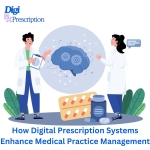
How Digital Prescription Systems Enhance Medical Practice Management
The healthcare industry is rapidly evolving, and digital prescription systems are at the forefront of this transformation. These systems not only simplify the process of prescription writing but also play a pivotal role in enhancing overall medical practice management. From improving accuracy to streamlining workflows, digital prescription systems are becoming essential tools for modern clinics.
In this blog, we’ll explore how these systems empower healthcare professionals to manage their practices more effectively while providing better patient care.
1. Streamlining Prescription Writing
Traditional handwritten prescriptions are prone to errors and inefficiencies. Digital prescription systems eliminate these issues by automating and simplifying the process.
- Faster Prescription Generation:
Doctors can create and print prescriptions in seconds using pre-configured templates. - Reduced Errors:
The system minimizes errors caused by illegible handwriting or incorrect medication details. - Automated Dosage Recommendations:
These tools provide automated suggestions for drug dosages based on patient information.
2. Centralized Patient Records
Digital prescription systems allow doctors to access and manage patient records seamlessly.
- Comprehensive Medical Histories:
All patient information, including past prescriptions, lab results, and diagnoses, is stored in a single platform. - Quick Access:
Doctors can retrieve patient records instantly, enabling faster decision-making during consultations. - Improved Continuity of Care:
The system ensures that all patient interactions are documented, supporting better follow-ups.
3. Enhancing Appointment Management
Integrating digital prescription systems with appointment scheduling tools helps clinics operate more efficiently.
- Automated Scheduling:
Doctors can set up and manage their appointment calendars with ease. - Reduced No-Shows:
Automated reminders sent to patients reduce missed appointments, improving clinic revenue. - Streamlined Workflows:
With integrated systems, appointments and prescriptions are managed in one place, saving time and effort.
4. Secure and Efficient Payment Tracking
Many digital prescription systems include payment and billing features that simplify financial management.
- Online Payment Integration:
Platforms like PayPal and Stripe enable secure, cashless transactions for patient consultations. - Billing Automation:
Doctors can generate invoices automatically, reducing administrative burdens. - Financial Reporting:
The system provides detailed reports on revenue and expenses, aiding better financial planning.
5. Better Compliance with Healthcare Standards
Digital prescription systems are designed to comply with industry standards and regulations, ensuring safe and ethical medical practices.
- Standardized Prescriptions:
Systems generate prescriptions that meet regulatory requirements, including proper drug labeling and instructions. - Data Security:
Advanced encryption protects patient data, ensuring compliance with privacy laws. - Easier Audits:
Comprehensive digital records simplify audits and inspections, reducing compliance risks.
6. Boosting Patient Satisfaction
Patients value convenience, and digital prescription systems help doctors provide a smoother healthcare experience.
- Improved Accuracy:
Accurate prescriptions reduce the risk of medication errors, ensuring better patient outcomes. - Time-Saving Solutions:
Patients spend less time at the clinic as prescriptions are generated quickly and efficiently. - Online Consultations:
Many systems support telemedicine, allowing patients to receive prescriptions without visiting the clinic.
7. Real-Time Analytics for Better Decision-Making
Data analytics is a powerful feature of digital prescription systems that supports better decision-making.
- Patient Trends:
Doctors can analyze patient data to identify trends and improve treatment plans. - Performance Metrics:
Clinics can track appointment volumes, revenue, and other key metrics to optimize operations. - Inventory Management:
Systems can monitor medication stock levels, ensuring that essential drugs are always available.
8. Increased Efficiency for Healthcare Teams
Digital tools free up time for doctors and support staff by automating routine tasks.
- Staff Collaboration:
Shared platforms enable seamless communication between doctors, nurses, and administrative staff. - Time Management:
Automated processes allow healthcare teams to focus on patient care rather than paperwork. - Scalability:
Clinics can handle higher patient volumes without sacrificing quality, thanks to streamlined workflows.
The Role of Digital Prescription Systems in Bangladesh
In Bangladesh, where healthcare infrastructure often struggles to keep up with demand, digital prescription systems are game-changers.
- Urban and Rural Reach:
These tools bridge the gap between urban specialists and rural patients by facilitating online consultations. - Affordable Solutions:
Platforms like Digi Prescription make digital tools accessible to clinics of all sizes. - Improved Outcomes:
By enhancing accuracy and efficiency, these systems contribute to better health outcomes nationwide.
Conclusion
Digital prescription systems are more than just a technological upgrade—they are a necessity for modern medical practice management. By streamlining workflows, improving accuracy, and enhancing patient satisfaction, these tools enable healthcare providers to focus on what matters most: delivering quality care.
For doctors looking to future-proof their practices, adopting a digital prescription system is a step in the right direction. The time to embrace this technology is now!
